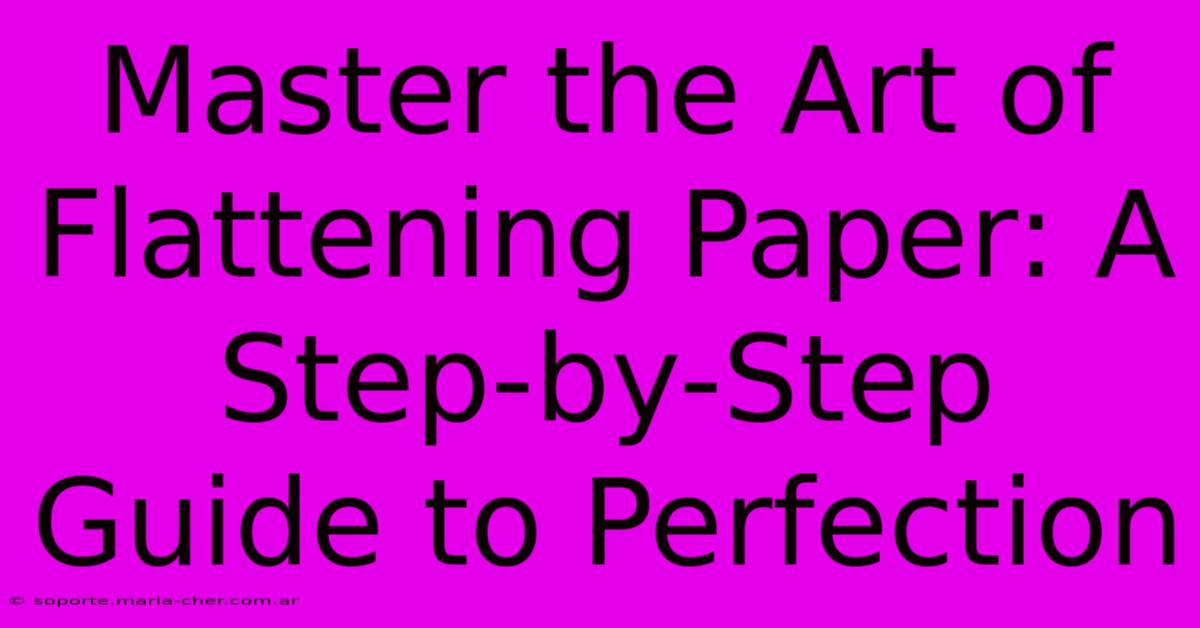Master The Art Of Flattening Paper: A Step-by-Step Guide To Perfection

Table of Contents
Master the Art of Flattening Paper: A Step-by-Step Guide to Perfection
Are you tired of wrinkled, creased documents and precious photographs? Do you dream of flawlessly flat papers for framing, scanning, or archiving? Then you've come to the right place! This comprehensive guide will walk you through various techniques to master the art of flattening paper, achieving that coveted pristine finish. Whether you're dealing with a single, slightly crumpled sheet or a stack of aged documents, we've got you covered.
Why Flattening Paper Matters
Before we dive into the techniques, let's understand why flattening paper is crucial. Beyond aesthetics, flattening is essential for:
- Preservation: Flattening helps prevent further damage to delicate papers, extending their lifespan.
- Scanning and Digitization: Wrinkles and creases create distortions in scanned images, impacting their quality.
- Framing and Display: A flat surface is vital for a professional and attractive presentation.
- Professional Appearance: Flattened documents present a polished image for important documents or presentations.
Methods for Flattening Paper: From Simple to Advanced
The best method for flattening paper depends on the severity of the creases, the type of paper, and the tools you have available. Let's explore several effective techniques:
1. The Simple Press Method: For Minor Creases
This is perfect for papers with only slight wrinkles.
- What you'll need: Heavy books or other flat, heavy objects.
- How to do it: Place the paper between several heavy books or other flat weights. Leave it undisturbed for several days, or even a week for stubborn creases. The weight gradually flattens the paper.
2. The Ironing Method: A Quick Solution for Light Creasing
This method is faster than the press method but requires caution to avoid damaging the paper.
- What you'll need: Iron, ironing board (optional), a thin cotton cloth or parchment paper.
- How to do it: Place the paper on the ironing board or a flat, heat-resistant surface. Cover it with a thin cloth or parchment paper to prevent scorching. Set your iron to a low setting – no steam! Gently iron over the paper, moving the iron constantly to prevent burning. Check frequently to avoid overheating.
3. The Book Pressing Method: For Moderate Creases
This technique uses the weight of books to press out moderate wrinkles.
- What you'll need: Many heavy books, a flat surface, archival-quality tissue paper (optional).
- How to do it: If using tissue paper, place the tissue paper between sheets of paper to prevent sticking. Sandwich the wrinkled paper between numerous heavy books. Leave under pressure for several weeks for optimal results.
4. The Vacuum Pressing Method: For Stubborn Creases and Delicate Papers
This advanced method is excellent for valuable documents or papers with significant creases. It uses vacuum pressure for even flattening.
- What you'll need: Vacuum press machine (available from art supply stores or online).
- How to do it: Follow the instructions provided with your vacuum press. Place the paper carefully between sheets of archival-quality board or foam core, ensuring even pressure distribution. Apply vacuum pressure for the recommended time.
5. The Dampening Method (Use with Caution!): For Extremely Stubborn Creases
This method is effective but requires extreme care to prevent damage. It's best suited for thicker papers.
- What you'll need: Spray bottle with distilled water, blotting paper, heavy books.
- How to do it: Lightly mist the paper with distilled water – avoid over-saturation. Blot away any excess moisture. Sandwich the dampened paper between sheets of blotting paper and place it under a heavy weight for several days. Monitor frequently to prevent mold or damage.
Tips for Success
- Always test a small, inconspicuous area first before applying any method to the entire paper.
- Use archival-quality materials whenever possible to prevent damage to your documents.
- Be patient: Flattening paper takes time. Don't rush the process.
- For valuable documents, consult a professional conservator.
By following these steps and selecting the appropriate method, you can successfully flatten your paper, preserving its beauty and value for years to come. Remember to always prioritize the preservation of your documents and choose the method that best suits your needs and the condition of your paper. Now go forth and achieve paper perfection!

Thank you for visiting our website wich cover about Master The Art Of Flattening Paper: A Step-by-Step Guide To Perfection. We hope the information provided has been useful to you. Feel free to contact us if you have any questions or need further assistance. See you next time and dont miss to bookmark.
Featured Posts
-
Empowering Nail Technicians The Ultimate Guide To Top Notch Builder Gels
Feb 09, 2025
-
Break The Copyright Code Unlocking The Legalities Of Stock Image Usage
Feb 09, 2025
-
Transform Your Art With Strathmores Bristol Board A Step By Step Guide
Feb 09, 2025
-
For Auld Lang Syne The Untold Story Behind A New Years Anthem
Feb 09, 2025
-
Tonsillectomy Price Puzzle Solved Unlocking The Best Value For Your Health
Feb 09, 2025
